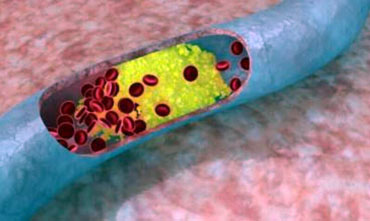
TCM Perspective On
AtherosclerosisAtherosclerosis of the heart, better known as coronary heart disease, is classified in Traditional Chinese Medicine (TCM) as chest pain syndrome. It is characterized by pain in the chest, which may progress towards the back. Patients can also have shortness of breath, especially when lying flat. Symptoms of heart atherosclerosis have been mentioned in ancient medical texts as far back as the Han Dynasty. The famous medical work, Huang Di Nei Jing included a detailed description of this disease, saying, "Patients with chest pain syndrome may have pain inside the chest, fullness and distention in the lower chest, pain in the back of the shoulder as well as pain in the upper arm."
Another example of early writing on this subject is the description in the Synopsis of the Golden Chamber written by the famous Chinese medical doctor Zhang Zhong Jing who was also from the Han Dynasty. He wrote, "Chest pain syndrome usually presents as wheezing and cough, pain in the back of the shoulder and shortness of breath. The pulse at the first position will be slow and sinking while the pulse at the second position will appear rapid with slight tightness. In this case, Gualou Shebai Decoction ( Melon pedicel and Longstamen onion bulb ) should be used." Since then, other works dealing with the symptoms, diagnosis and different treatments for atherosclerosis have been written at different times.
Western Point of View
Atherosclerosis is a slow disease in which your arteries become clogged and hardened. It is the underlying cause of most cases of heart attack, stroke, and vascular dementia, and is found in 80 to 90% of Americans over the age of 30. Fat, cholesterol, calcium, and other substances form plaque, which builds up in arteries. Hard plaque narrows the passage that blood flows through. That causes arteries to become stiff and inflexible (atherosclerosis is also known as hardening of the arteries). It contributes to the development of cardiovascular disease, which is the leading cause of death in people over 45. Soft plaque is more likely to break free from the artery wall and cause a blood clot, which can block blood flow to vital organs.
The effects of atherosclerosis differ depending upon which arteries in the body narrow and become clogged with plaque. If the arteries that bring oxygen-rich blood to your heart are affected, you may have coronary artery disease, chest pain, or a heart attack. If the arteries to your brain are affected, you may have a transient ischemic attack (TIA) or a stroke. If the arteries in your arms or legs are affected, you may develop peripheral artery disease. You may also develop a bulge in the artery wall (aneurysm).
Lowering blood pressure and LDL ("bad") cholesterol levels, eating a healthy diet with lots of fruits and vegetables, quitting smoking, losing weight, and getting more exercise can prevent atherosclerosis.